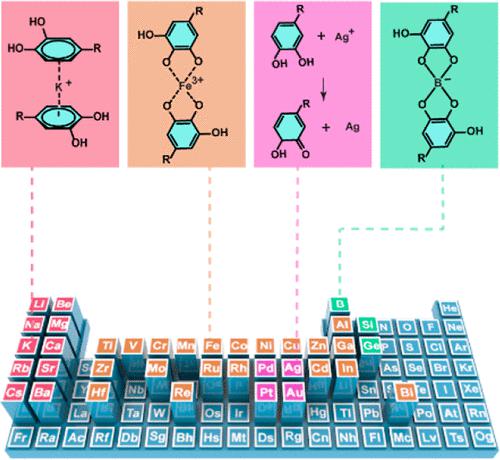当前位置:
X-MOL 学术
›
Chem. Rev.
›
论文详情
Our official English website, www.x-mol.net, welcomes your
feedback! (Note: you will need to create a separate account there.)
Metal Ion-Directed Functional Metal–Phenolic Materials
Chemical Reviews ( IF 51.4 ) Pub Date : 2022-05-10 , DOI: 10.1021/acs.chemrev.1c01042 Huimin Geng 1 , Qi-Zhi Zhong 1, 2 , Jianhua Li 3 , Zhixing Lin 2 , Jiwei Cui 1 , Frank Caruso 2 , Jingcheng Hao 1
Chemical Reviews ( IF 51.4 ) Pub Date : 2022-05-10 , DOI: 10.1021/acs.chemrev.1c01042 Huimin Geng 1 , Qi-Zhi Zhong 1, 2 , Jianhua Li 3 , Zhixing Lin 2 , Jiwei Cui 1 , Frank Caruso 2 , Jingcheng Hao 1
Affiliation

|
Metal ions are ubiquitous in nature and play significant roles in assembling functional materials in fields spanning chemistry, biology, and materials science. Metal–phenolic materials are assembled from phenolic components in the presence of metal ions through the formation of metal–organic complexes. Alkali, alkali-earth, transition, and noble metal ions as well as metalloids interacting with phenolic building blocks have been widely exploited to generate diverse hybrid materials. Despite extensive studies on the synthesis of metal–phenolic materials, a comprehensive summary of how metal ions guide the assembly of phenolic compounds is lacking. A fundamental understanding of the roles of metal ions in metal–phenolic materials engineering will facilitate the assembly of materials with specific and functional properties. In this review, we focus on the diversity and function of metal ions in metal–phenolic material engineering and emerging applications. Specifically, we discuss the range of underlying interactions, including (i) cation−π, (ii) coordination, (iii) redox, and (iv) dynamic covalent interactions, and highlight the wide range of material properties resulting from these interactions. Applications (e.g., biological, catalytic, and environmental) and perspectives of metal–phenolic materials are also highlighted.
中文翻译:

金属离子导向功能金属-酚醛材料
金属离子在自然界中无处不在,在化学、生物学和材料科学领域的功能材料组装中发挥着重要作用。金属-酚醛材料是在金属离子存在的情况下,通过金属-有机络合物的形成,由酚类组分组装而成。碱金属、碱土金属、过渡金属和贵金属离子以及与酚醛结构单元相互作用的准金属已被广泛用于生成各种杂化材料。尽管对金属-酚类材料的合成进行了广泛的研究,但仍缺乏关于金属离子如何指导酚类化合物组装的全面总结。对金属离子在金属酚醛材料工程中的作用的基本理解将有助于组装具有特定和功能特性的材料。在本次审查中,我们专注于金属离子在金属酚醛材料工程和新兴应用中的多样性和功能。具体来说,我们讨论了潜在相互作用的范围,包括(i)阳离子-π、(ii)配位、(iii)氧化还原和(iv)动态共价相互作用,并强调了由这些相互作用产生的广泛的材料特性。还强调了金属酚醛材料的应用(例如,生物、催化和环境)和前景。
更新日期:2022-05-10
中文翻译:

金属离子导向功能金属-酚醛材料
金属离子在自然界中无处不在,在化学、生物学和材料科学领域的功能材料组装中发挥着重要作用。金属-酚醛材料是在金属离子存在的情况下,通过金属-有机络合物的形成,由酚类组分组装而成。碱金属、碱土金属、过渡金属和贵金属离子以及与酚醛结构单元相互作用的准金属已被广泛用于生成各种杂化材料。尽管对金属-酚类材料的合成进行了广泛的研究,但仍缺乏关于金属离子如何指导酚类化合物组装的全面总结。对金属离子在金属酚醛材料工程中的作用的基本理解将有助于组装具有特定和功能特性的材料。在本次审查中,我们专注于金属离子在金属酚醛材料工程和新兴应用中的多样性和功能。具体来说,我们讨论了潜在相互作用的范围,包括(i)阳离子-π、(ii)配位、(iii)氧化还原和(iv)动态共价相互作用,并强调了由这些相互作用产生的广泛的材料特性。还强调了金属酚醛材料的应用(例如,生物、催化和环境)和前景。











































 京公网安备 11010802027423号
京公网安备 11010802027423号